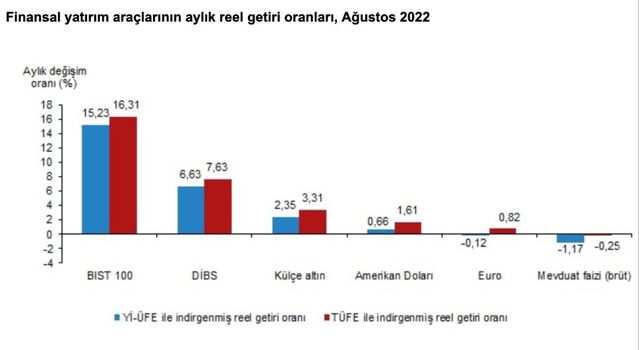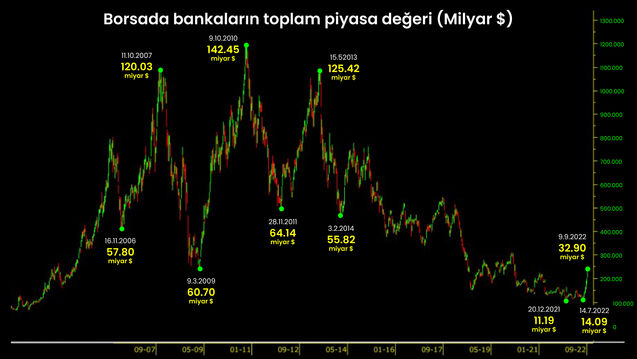The sharp rise triggered by foreign purchases in banks spread throughout the stock market. The movement that started in mid-July has not yet Before even two months, it caused a 137 percent increase in bank shares and a 48 percent increase in the stock market in general.
The revived stock market made a premium of 18.1 percent on the average index basis from July to August. When this premium is adjusted for monthly inflation, a real return of 16.3% remains.
➔With its 16.3 percent premium, the stock market became the most profitable investment tool both in August and this year. This level of real return was previously experienced in the dollar and euro in August 2018. In the stock market, the return of August 2009 was exceeded.
➔In the stock market, which has been climbing since mid-July The total market capitalization of the companies increased from $144.5 billion to $198.2 billion. An increase of 53.2 billion dollars in dollar terms corresponds to a 37 percent growth.
➔This increase in the stock market value was caught in a short period of 56 days. Almost every day, 1 billion dollars increase in value is falling.
➔With this level The market value of the stock market rose to $200 billion, and the dollar value of the stock market index rose to $1.93 and reached $2.
The last record level that the stock market index left behind on May 22, 2013 was $5.10. In fact, the stock market is not even halfway to the record with its latest rise. It’s still at 38 percent.
ATTRACTION TO THE MOST PROFITABLE SECTOR
➔It is the banks that ventilate the stock market. While its weight in the Stock Exchange Index was more than 50 percent for many years, it had decreased to around 10 percent. The total market value of the banks had fallen to one-tenth.
➔Banks, which rose to a market value of 142.4 billion dollars in November 2010, lost value as they lost value in the intervening time.
With the effect of the rapid increase in the dollar exchange rate on December 20, 2021, the market value of banks decreased to 11.2 billion dollars. Thus, banks fell to their lowest level since the 2001 crisis after 20 years.
➔On July 14, this value was 14.1 billion dollars. Climbing from there The value of banks rose to $32.9 billion on September 9th. A market capitalization of $18.8 billion and an increase of 133.4 percent fit into 56 days.
It doesn’t matter what’s going on behind the banks making such a premium. The important thing is that the curve coincides with the right one and the banks are treated as swamps.
➔It means that an industry whose value has lost 90 percent normally suffers from swamp pricing.
➔ However, banks are the institutions that provide the most profit increase this year. In the 7-month period, their profits increased by 505 percent.
CHANGE OF THE EXCHANGE
➔Though we don’t know if this snow will stay with them. With any arrangement these profits could well be pruned.
➔Let’s say nothing was done and they ended the year with high profitability. We do not know to what extent the BRSA will allow profit distributions. Beginning in 2008 and arguing that capital reinforcements are needed during the global crisis, dividend distribution is restricted.
➔The foreign purchase of 274 million dollars, which triggered the bank shares, slowed down, but once the banks were active, the locals were also involved.
➔It is possible to say that banks have recently acted as a lever that activates the stock market..
➔Although 35 percent of the increase in market value was due to banks, 65 percent was made up of non-bank stocks.
➔At the end of the buying wave that spread from banks to other sectors, we saw that the total market value of the stock market increased by 53 billion dollars.
4 REASONS FOR BANK AND EXCHANGE EXCHANGE
➔When banks fire the entire stock market The reason lies in the fact that it has dropped to one tenth of its previous price. Stocks most suitable for purchase.
In addition, companies are making the highest profits in their history. Banks started to experience the same profitability this year.
➔There was a serious negative divergence between Borsa İstanbul and other emerging stock markets. Borsa İstanbul was trading at a half discount on average from other stock exchanges.
➔There is also selection pricing. Our stock market revived almost before every election.
➔For all these reasons, the purchase in the banks ignited the stock market. Although bank shares have fallen to one-tenth in dollar terms, it has approached one-fourth of its former price level with its exit since mid-July. If the 2010 value is $100, the September 9, 2022 value is $23.
➔ While banks found value in the stock market at 40 percent of their book value, this rate increased to 68 percent. Developing country banks have not yet been able to capture their value or book value.
WILL IT CONTINUE?
For the first time in more than 10 years, the banking sector has caught such investor interest.
If we go through the valuation, it can be said that the banking sector has a long way to go.
➔However, the most profitable period for the sector may be the third quarter we are in.
➔Because As the banks were forced to buy with the change in the credit policy, there were dramatic decreases in Treasury interest rates.
➔For banks with a portfolio of government securities laden with interest rate drops, it means a one-time write off of high capital gains.
➔Alone Interest rates have also reached 11-12%. How long will Turkey be able to continue to apply the deepest negative interest rate in the history of the world and the republic, while the inflation is in the 80-140 percent band?
➔There is not much room left to lower interest rates in the next quarter. At one stage When the interest rates correct, the bond portfolio, which prints high profits for the banks today, will start to print losses.
EYES ON US INFLATION AND INTERESTS
In the global markets, three issues stand out. US CPI will be released on Tuesday. The expected figure is to decrease from 8.5 percent to 8.1 percent. High or low, both directions have their supporters. So fluctuations in the markets are inevitable.
In addition, the Fed has been reducing its balance sheet by $47.5 billion per month since June 1st. As of September, this figure increases to 95 billion dollars per month.
➔How will this speed affect the bond market? Experts He argues that every $1 trillion meltdown in the balance sheet corresponds to a 25 basis point increase in interest rates.
In this case, how will the ongoing and will continue balance sheet shrinkage affect the economy? Even if there is no recession, the appetite to borrow and invest in an economy that will start to slow down will gradually decrease.
➔As the ECB has increased and will continue to increase interest rates, the short-term depreciation of the Euro may have stopped, or it may even move in the direction of appreciation.
The appreciation of the euro also means the weakening of the dollar. The weakening of the dollar is very beneficial for the stock markets. The movement observed in the indices in recent days may have a certain share in this.
➔After Powell, Lagarde also did not go further. “correct” His speech was good for the markets. But one question remains relevant for both presidents, especially for Lagarde: How long will they be able to stay together?


